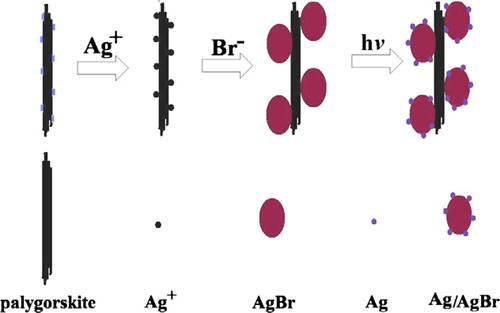Recycling of CO2 to chemicals has been an increasingly important research topic due to its desirable role in alleviating fossil fuel depletion and the global warming problem. Nevertheless, CO2 reduction is an energy intensive and thermodynamically unfavorable process because of the inert properties of CO2. If a renewable energy source (e.g., solar energy and hydrogen energy) can be used to convert CO2 in a friendly manner, CO2 reduction such as photocatalytic reduction should be a promising technical and environmentally friendly solution.
Researchers at State Key Laboratory for Oxo Synthesis and Selective Oxidation, Lanzhou Institute of Chemical Physics, Chinese Academy of Sciences, and Jiyuan Vocational and Technical Collage have prepared high surface area AgBr/palygorskite composite photocatalysts with palygorskite as a matrix by an in situ ectrostatic adsorption–deposition–precipitation method for visible light induced CO2 reduction and Rh B decolorization.
 |
|
Schematic illustration of Ag/AgBr assembled on the surface of palygorskite. |
Due to the effect of cation exchange, bromine precursor has a significant effect on the dispersity of AgBr on palygorskite surface and moreover on the photocatalytic performance of AgBr/palygorskite. Compared with the corresponding bare AgBr particle, the assembled material exhibits excellent photocatalytic activity for the decolorization of cationic Rh B dye and the reduction of CO2 to CH4 under visible light irradiation. The porous structure and larger specific surface area of palygorskite could mainly account for the excellent photocatalytic activity of AgBr/ palygorskite. In addition, negative charge of palygorskite particles could facilitate the adsorption and accumulation of cationic Rh B dye on the AgBr surface due to electrostatic interactions, which could enhance the photocatalytic performance. The channel of palygorskite could enhance the stability of AgBr/palygorskite by inhibiting the loss of Br atom. This study will promote and broaden practical applications of plasmonic photocatalysts in environmental and energy issues.
The work has received support from the National Science Foundation of China, the National Basic Research Program of China, Henan Educational Committee, and Jiyuan Vocational and Technical Collage. The findings have been published in Journal of Colloid and Interface Science(Journal of Colloid and Interface Science377 (2012) 277–283).
